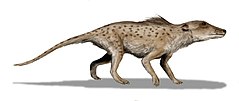Cetartiodactyla Bibliografia | Menu nawigacyjne
Ssaki
rządnadrządgenetycznychssakówhipopotamowateświniokształtnychWhippomorphaprzeżuwaczeCetruminantiaArtiofabula2005kopytnychwalenirodzinrzędów
| Cetartiodactyla | |
 Prawaleń Pakicetus | |
Systematyka | |
Domena | eukarionty |
Królestwo | zwierzęta |
Typ | strunowce |
| Podtyp | kręgowce |
Gromada | ssaki |
| Podgromada | żyworodne |
| Infragromada | łożyskowce |
| Nadrząd | Laurasiatheria |
Rząd | Cetartiodactyla |
Cetartiodactyla – rząd (lub nadrząd) ssaków łożyskowych, który został utworzony w wyniku najnowszych badań genetycznych i molekularnych gromady ssaków. Grupa ta nie ma aktualnie nazwy w języku polskim. Podział na poszczególne klady przedstawia się następująco:
Cetartiodactyla:
Tylopoda (Wielbłądy + wymarli krewni)
Artiofabula:
Świniokształtne (Suina)
Cetruminantia:
Przeżuwacze (Ruminantia)
Whippomorpha:
Hipopotamowate (Hippopotamidae)
Walenie (Cetacea)
W wyniku przeprowadzonych badań okazuje się, że hipopotamowate są daleko spokrewnione ze świniowatymi i tym samym nie należą do świniokształtnych. Za najbliższych natomiast krewnych Whippomorpha uważa się przeżuwacze (np. krowy i owce), z którymi tworzą Cetruminantia. Ta zaś grupa wraz ze wspomnianymi wcześniej świniowatymi należy do Artiofabula. Tylopody (wielbłądy i ich wymarli krewni) okazały się na tyle specyficzne molekularnie, genetycznie jak i morfologicznie, iż zaliczono je bezpośrednio do Cetartiodactyla.
Boisserie i in. (2005) przebadali dla potwierdzenia powyższej tezy szczątki większości wymarłych znanych ssaków kopytnych i waleni. Wśród wymienionych tu rodzin i rzędów zauważyli 80 charakterystycznych cech, dzięki którym można wprowadzić taki podział ssaków.
Bibliografia |
- Boissere, J.-R., F. Lihoreau, and M. Brunet. 2005. The position of Hippopotamidae within Cetartiodactyla. Proceedings of the National Academy of Sciences of the United States of America, 102:1537-1541.
- Gatesy, J. 1997. More support for a Cetacea / Hippopotamidae clade: The blood clotting protein gene g-fibrinogen. Molecular Biology and Evolution, 14:537-543.
- Gatesy, J., C. Hayashi, M. Cronin, and P. Arctander. 1996. Evidence from milk casein genes that cetaceans are close relatives of hippopotamid artiodactyls. Molecular Biology and Evolution, 13:954-963.
- Gatesy, J., C. Mathee. R. DeSalle, and C. Hayashi. 2002. Resolution of a supertree/supermatrix paradox. Systematic Biology, 51:652-664.
- Gatesy, J., M. Milinkovitch, V. Waddell, and M. Stanhope. 1999. Stability of cladistic relationships between Cetacea and higher-level artiodactyl taxa. Systematic Biology, 48:6-20.
- Grauer, D. and D. Higgins. 1994. Molecular evidence for the inclusion of cetaceans within the order Artiodactyla. Molecular Biology and Evolution, 11:357-364.
- Milinkovitch, M. C. and J. G. M. Thewissen. 1997. Even-toed fingerprints on whale ancestry. Nature, 388:622-624.
- Montgelard, C., F. Catzeflis, and E. Douzery. 1997. Phylogenetic relationships among cetartiodactyls and cetaceans as deduced from the comparison of cytochrome b and 12S RNA mitochondrial sequences. Molecular Biology and Evolution, 14:550-559.
- Naylor, G. J. P. and D. C. Adams. 2001. Are the fossil data really at odds with the molecular data? Morphological evidence for Cetartiodactyla phylogeny reexamined. Systematic Biology, 50:444-453.
- O'Leary, M. A. and J. H. Geisler. 1999. The position of Cetacea within Mammalia: phylogenetic analysis of morphological data from extinct and extant taxa. Systematic Biology, 48:455-490.
- Nikaido M, Rooney AP, Okada N (1999) Phylogenetic relationships among cetartiodactyls based on insertions of short and long interpersed elements: Hippopotamuses are the closest extant relatives of whales. Proc Natl Acad Sci U S A 96: 10261–10266.
- Shedlock, A. M., M. C. Milinkovitch, and N. Okada. 2000. SINE evolution, missing data, and the origin of whales. Systematic Biology, 49:808-816.
- Shimamura, M., H. Yasue, K. Ohshima, H. Abe, H. Kato, T. Kishiro, M. Goto, I. Munechika, and N. Okada. 1997. Molecular evidence from retroposons that whales form a clade within even-toed ungulates. Nature, 388:666-670.
- Thewissen, J. G., E. M. Williams, L. J. Roe, and S. T. Hussain. Skeletons of terrestrial cetaceans and the relationship of whales to artiodactyls. Nature, 413:277-281.